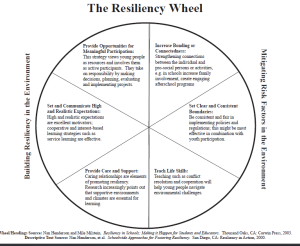I spent quite some time this week at an Education Summit in NC. The whole focus was on reconnecting the community to the school – an issue that I am very passionate about. There were some really good sessions on how to increase the voice of business and industry in shaping curriculum as well as the integration of global education into the curriculum. The charter school presentation was very interesting as they took an impressive approach to creating innovative learning environments – one of the featured schools was Roger Bacon Academy. Just take a look at their mission:
Thus, the mission of The Roger Bacon Academy is, for the next generation,
• to teach the rules and techniques for effective expression and communication in the arts and sciences,
• to communicate, by these arts and sciences, our understandings of the universe and our role in it, and
• to instill a love of learning and discovery, justifying a life-long dedication to health, truth, and virtue.
I highlighted a few words that jumped out at me as these words speak to the “creative economy” [more to come].
Another presentation featured 4 different perspectives on integration of global education into schools. I was fairly impressed with the work of NC’s Global Schools Network as well as UNC’s World View to really help students connect with other cultures and gain a much broader awareness of how the global economy impacts them. This is a great step that quite a few school districts in NC have taken, but there is still a glaring gap – – where is the “hands-on” application of this learning? Cultural immersion and international understanding are great foundations to a creative economy, but students need to be involved in solving problems and working with local and global communities to solve these problems. That is where relevance in the curriculum becomes tangible.
So with all of this movement to try and change education and impact learning through innovation and global awareness, where do we stand in terms of our role [education] in fostering this creative economy?
In 2008 Mark McGuinness wrote that “Creativity is the new competitive advantage . . .” America’s ability to be creative in solving problems and communication continues to be one of the driving tenets of our competitiveness. How are we fostering this in our K-12 schools? I came across this really cool Community Health Tool that allows you to look at counties in NC from a few different “health” indicators – one of which is the creative economy. What most intrigued me were the 3 strategies to increase the creative economy in these counties.
- Foster partnerships among creative enterprises
- Infuse creative practices into schools’ core curricula
- Cultivate creative assets to raise awareness of creativity
In the era of high stakes testing and “data, data, data”, it seems much more difficult to integrate these strategies into our educational fabric. After perusing the health tool, the percentage of creative economy jobs is still well below 10%. The higher percentages are directly related to the presence of a major university also. However, with technology and the ability to telecommute and telework, why aren’t we continuing to develop this creative economy through the state (and nation)? I believe the answer lies in the fact that we haven’t infused the 3 strategies above more deliberately into our K12 system. We have pushed standards and testing so hard that we have literally killed creativity.
While standardization is a necessary evil, the methods in which formative and summative assessment are utilized should allow students more diversity [and creativity] in proving learning has occurred. Paper and pencil testing is archaic and does not mirror a knowledge economy in which information is gathered, processed and refined into solutions and new products. I have always envisioned a learning ecosystem that allows students to connect, create, innovate and shape their learning with the tools of the Knowledge Age. Thus, I would champion loudly for the #2 strategy of “infusing creative practices into schools’ core curricula”. Such strategies can be seen in places like the Carpe Diem schools where blended, innovative learning allows a creative culture to thrive.
When a culture of creativity thrives, a creative economy can begin to blossom. Manufacturing and government jobs may continue to dominate our economy, but in order to hold our competitive advantage, educators need to seriously look at how we are building the next generation of workers to compete – – are we fostering the creative economy? In our classrooms are we allowing discovery to happen? Are we connecting the arts and sciences and demonstrating through hands-on application where students better understand their role in the universe? Awareness is just one step – – let’s move to action and change!


